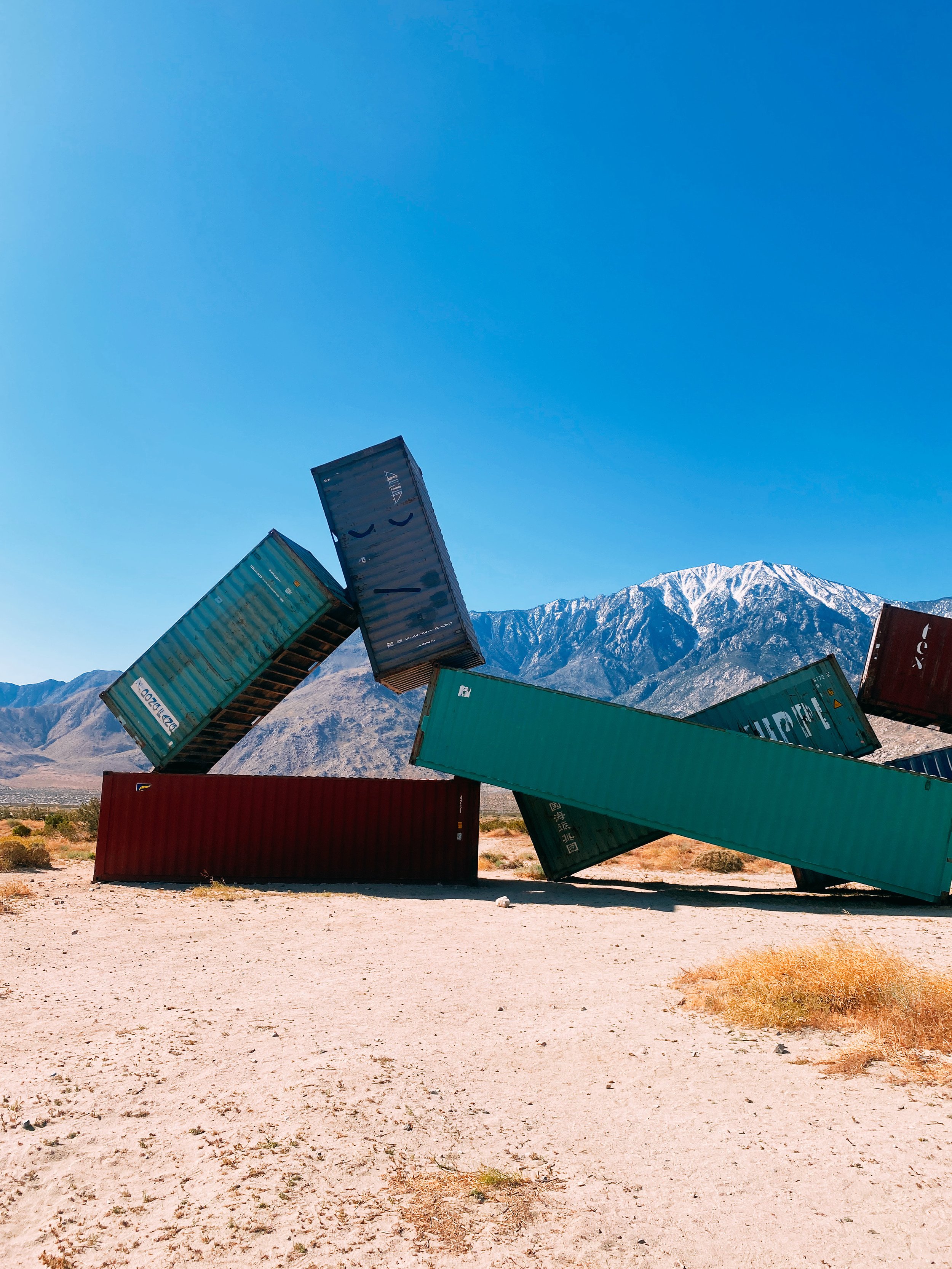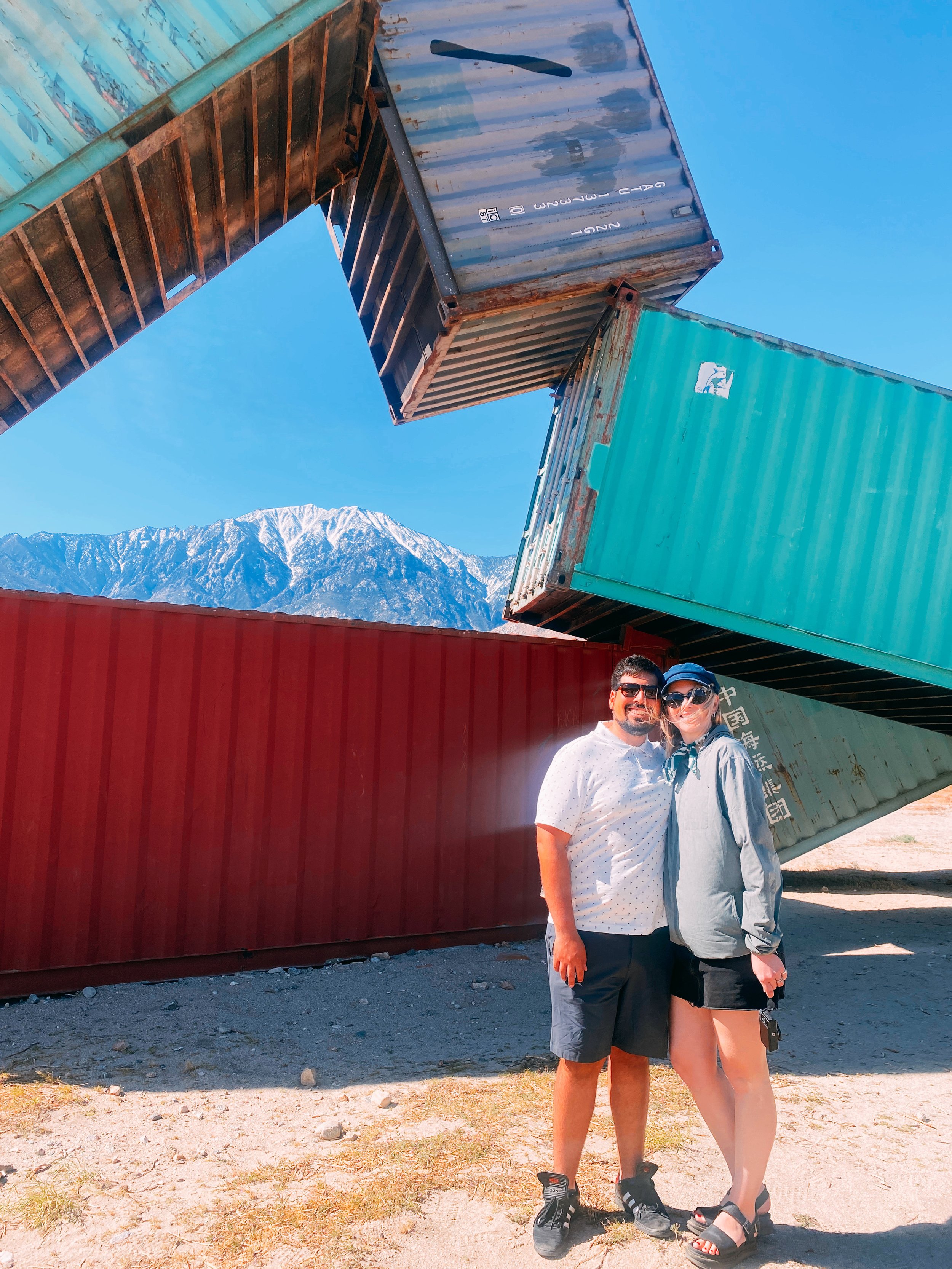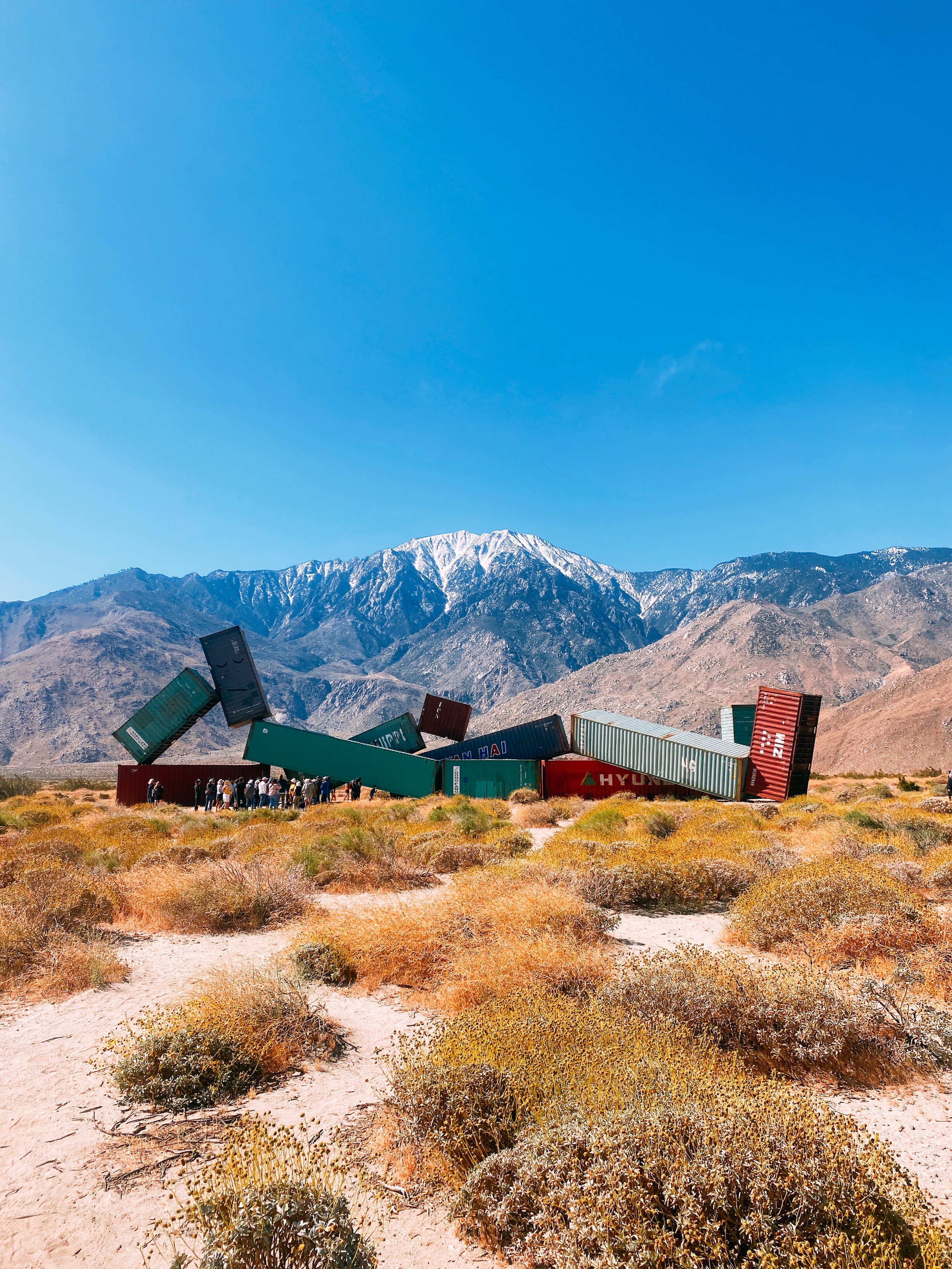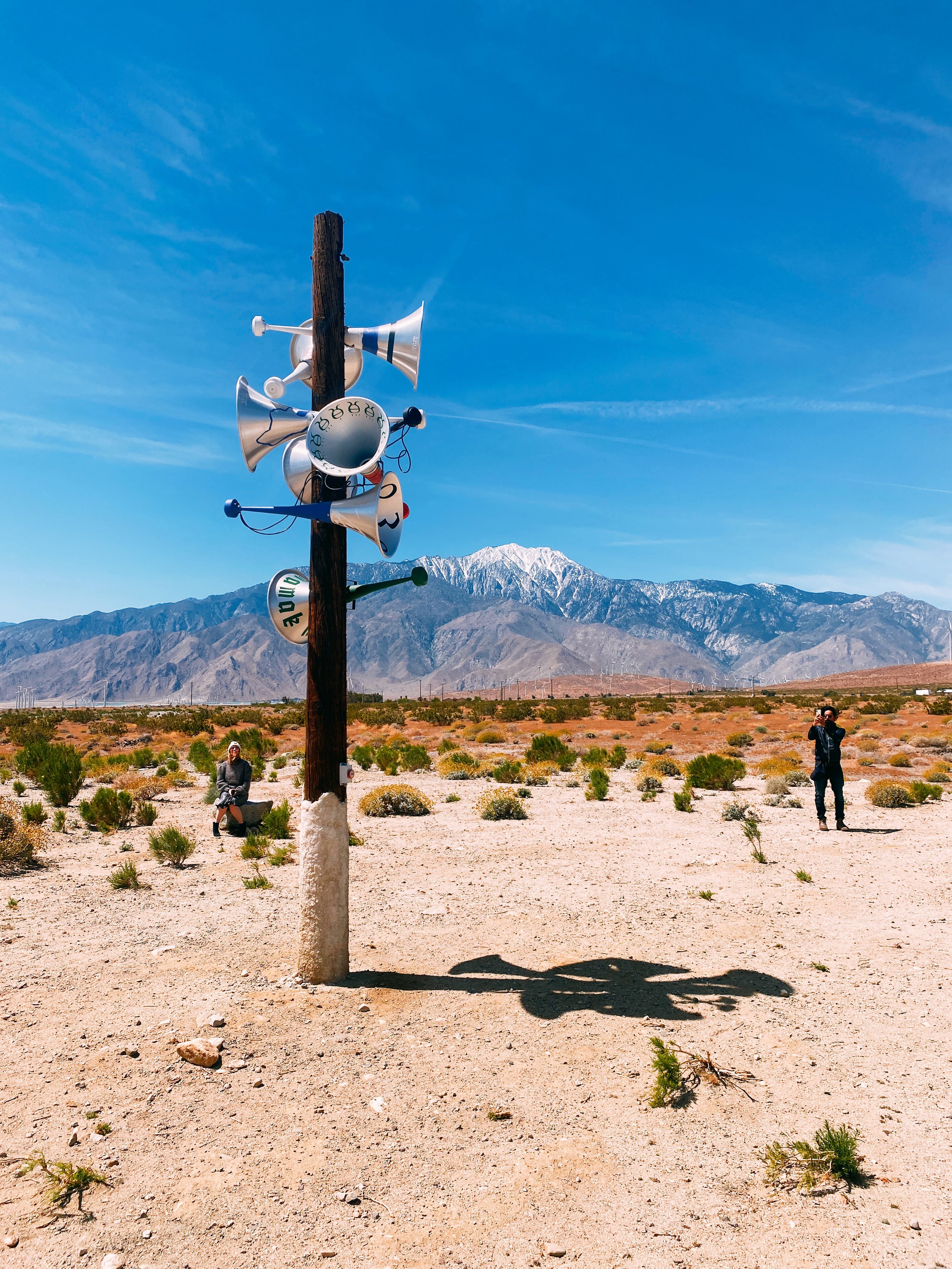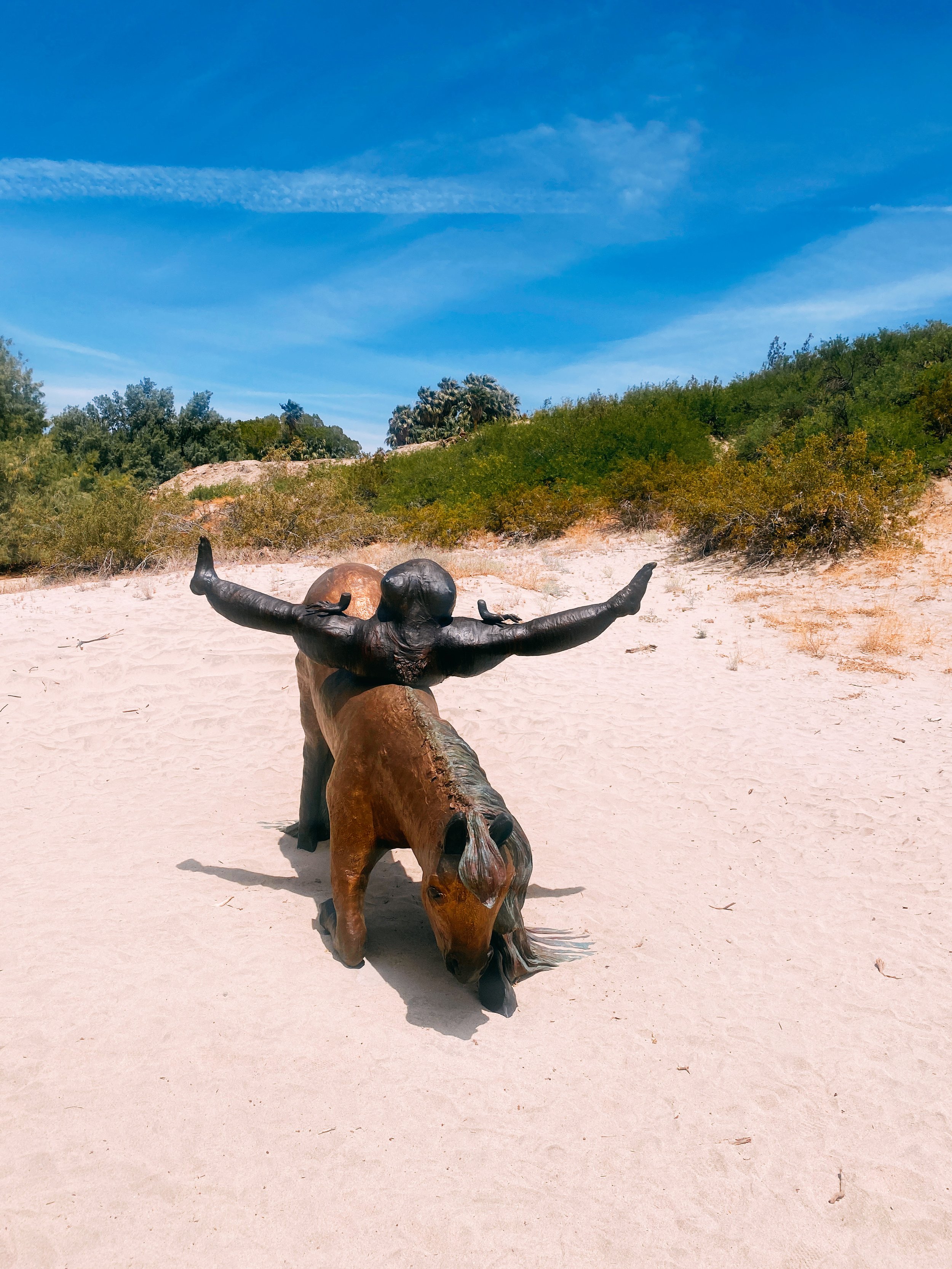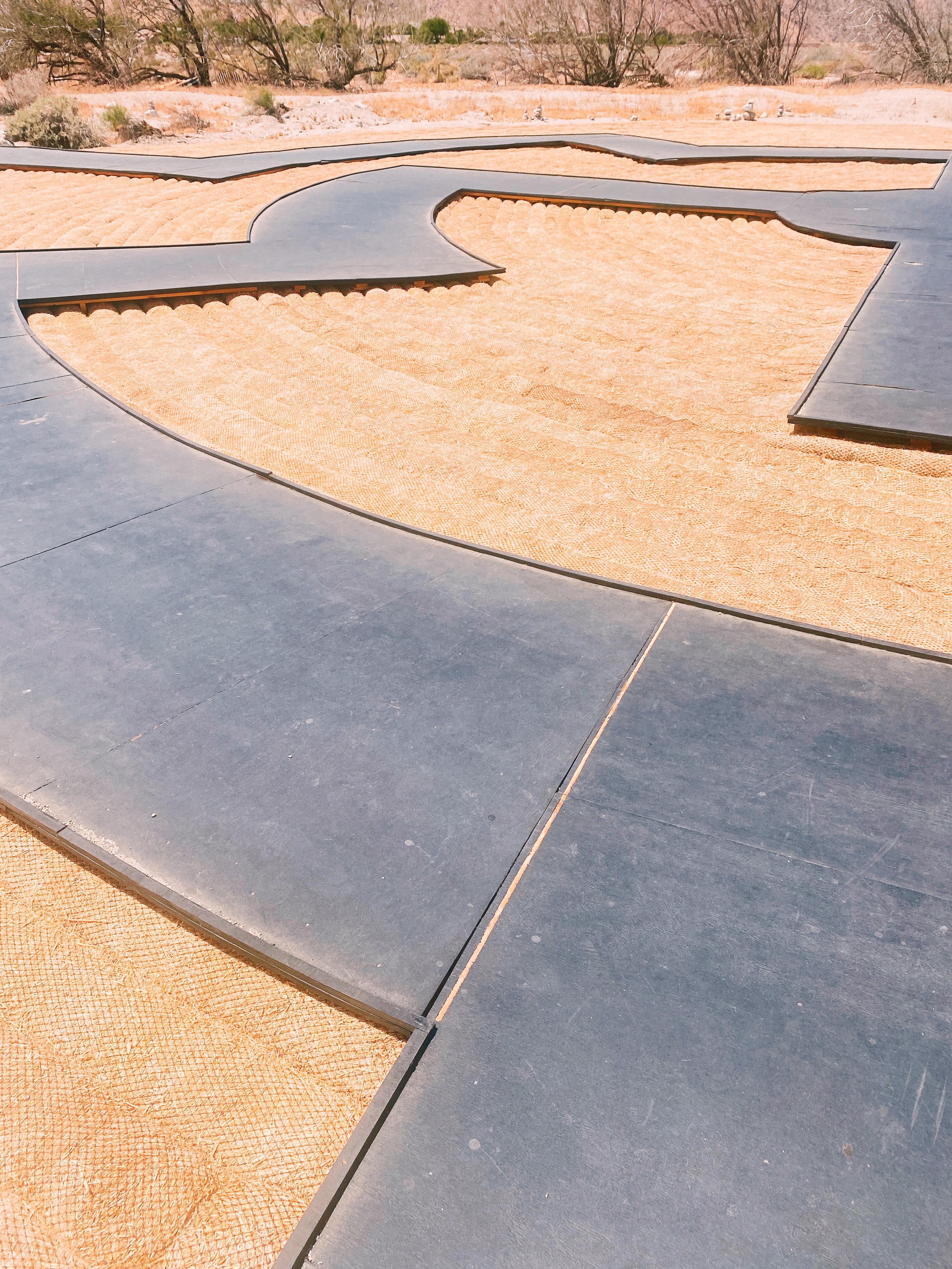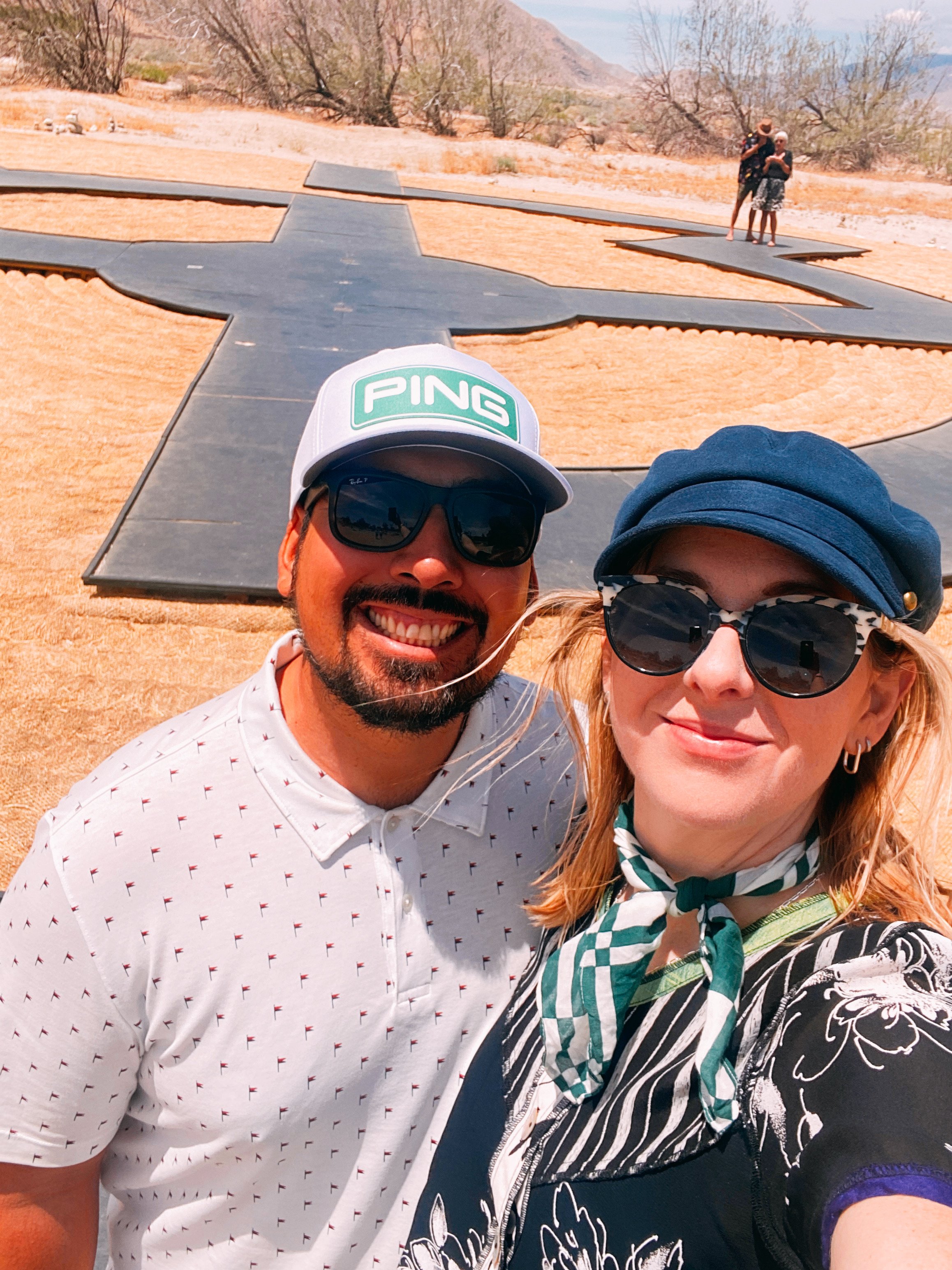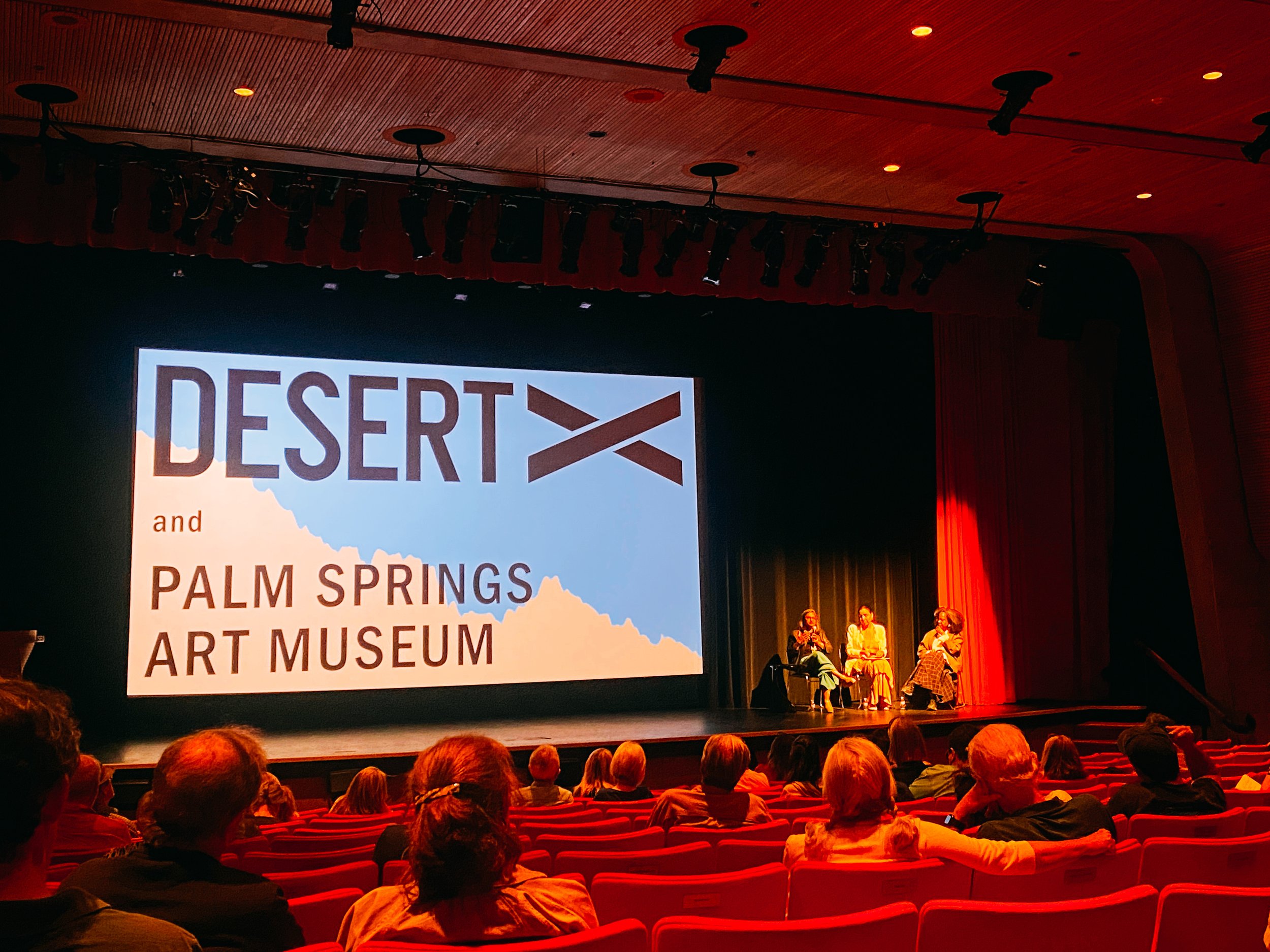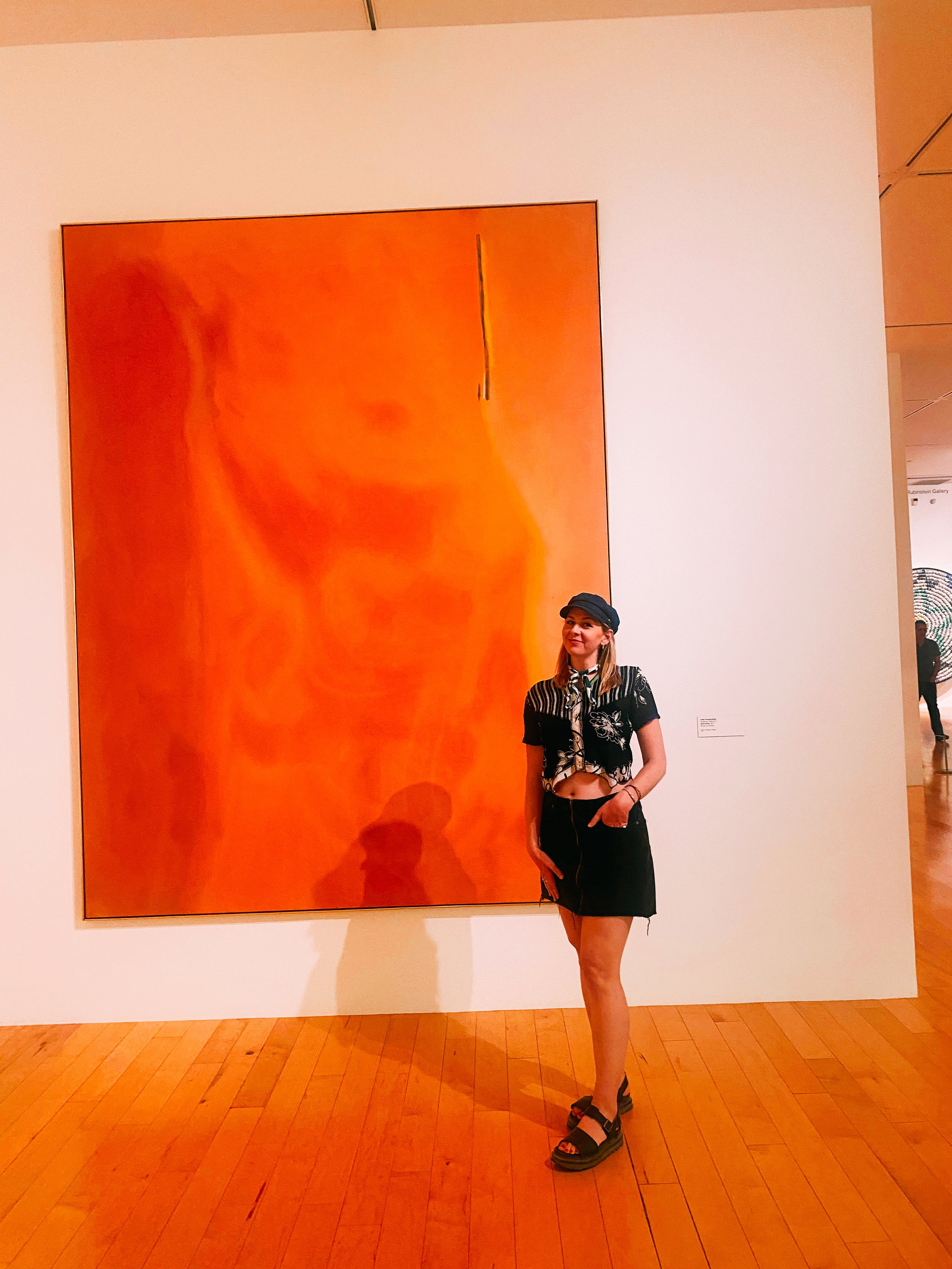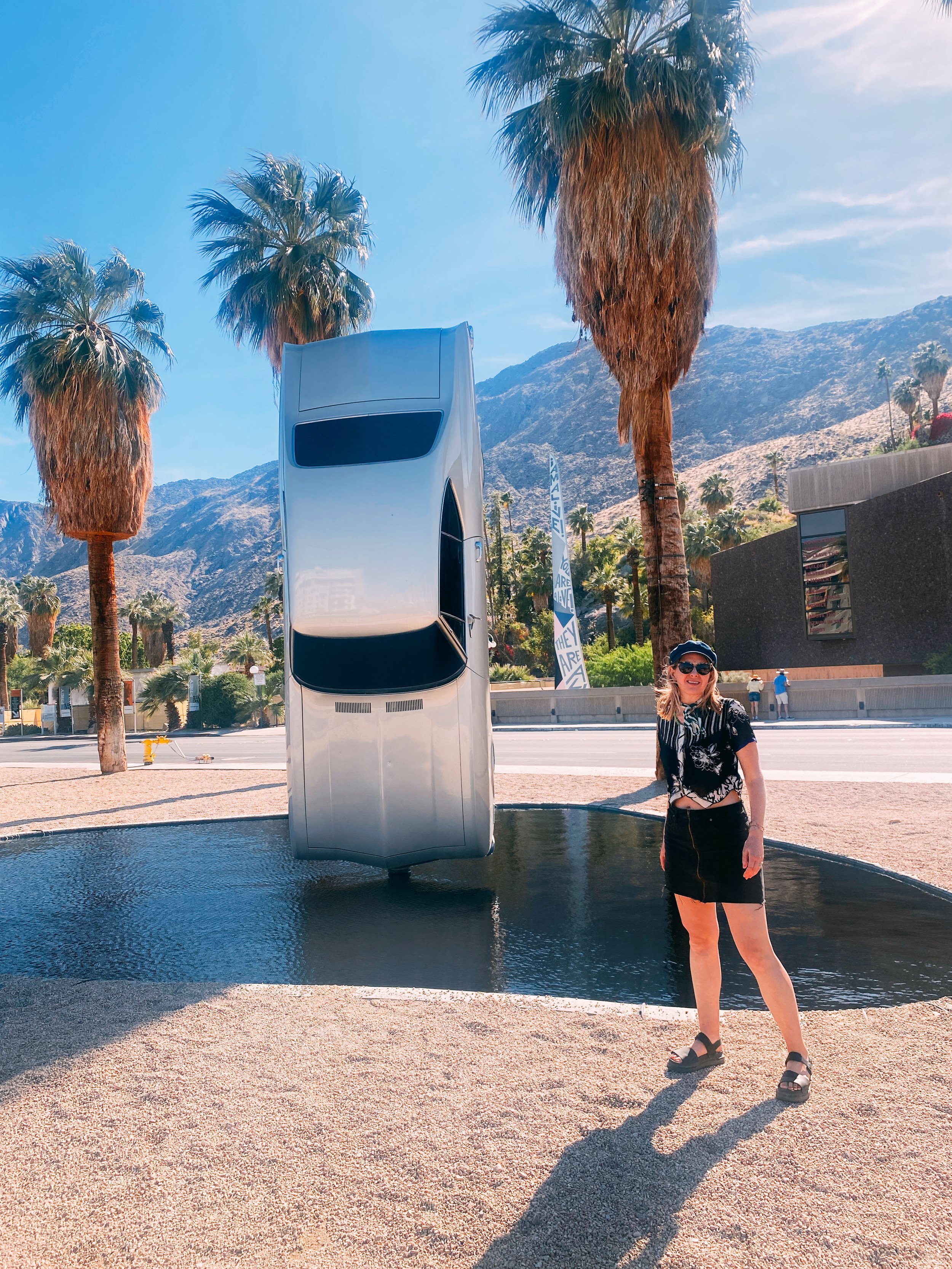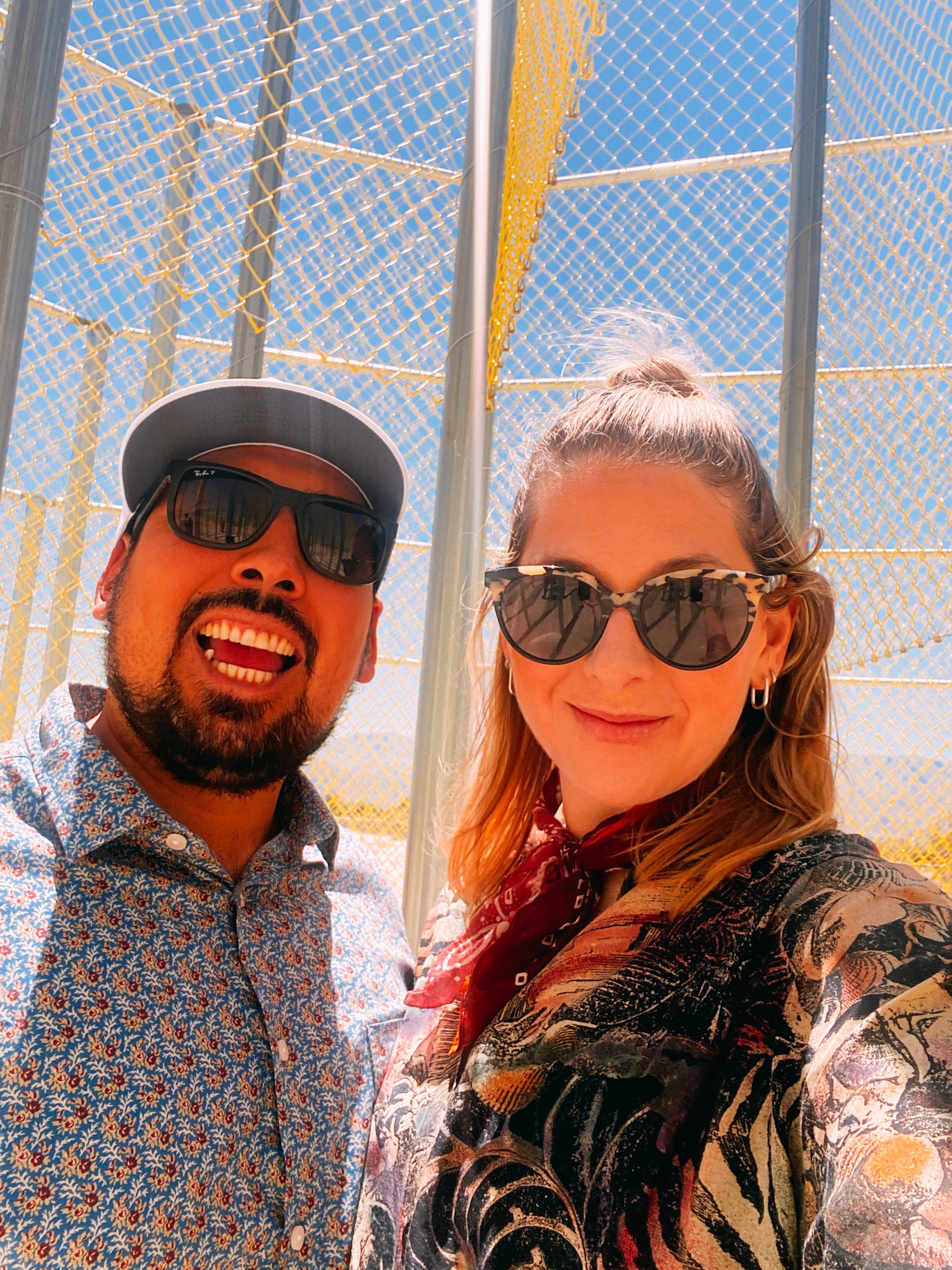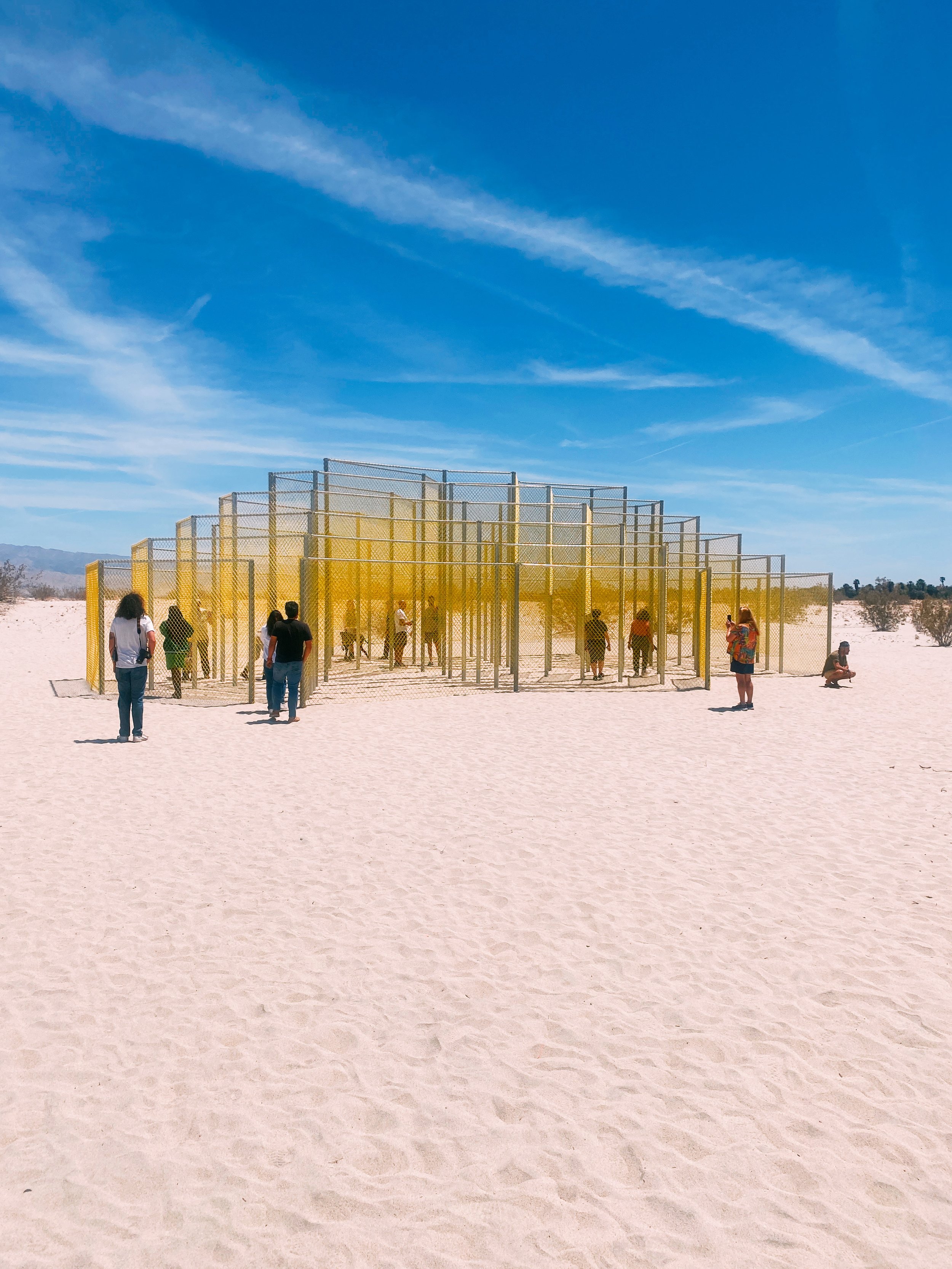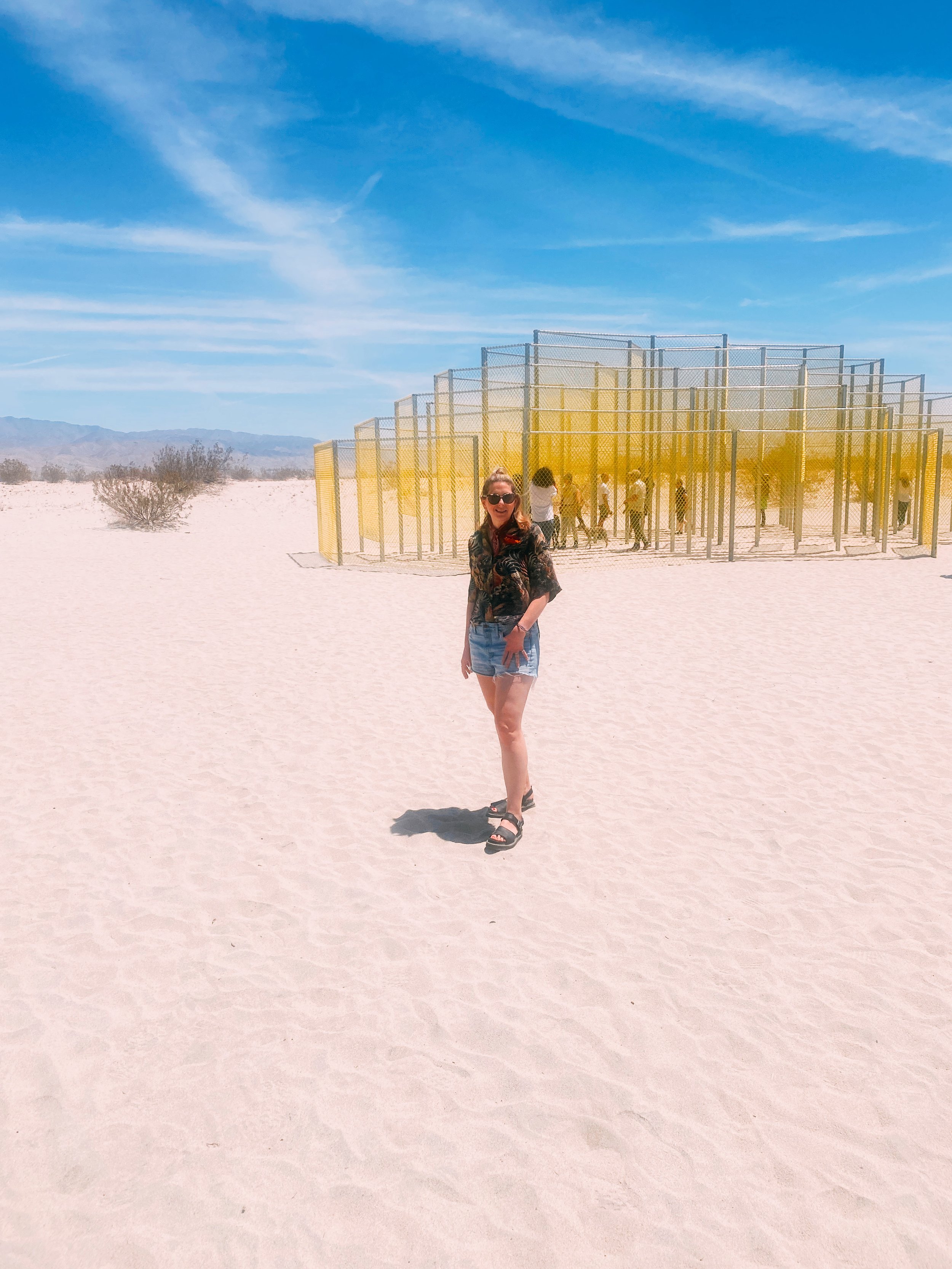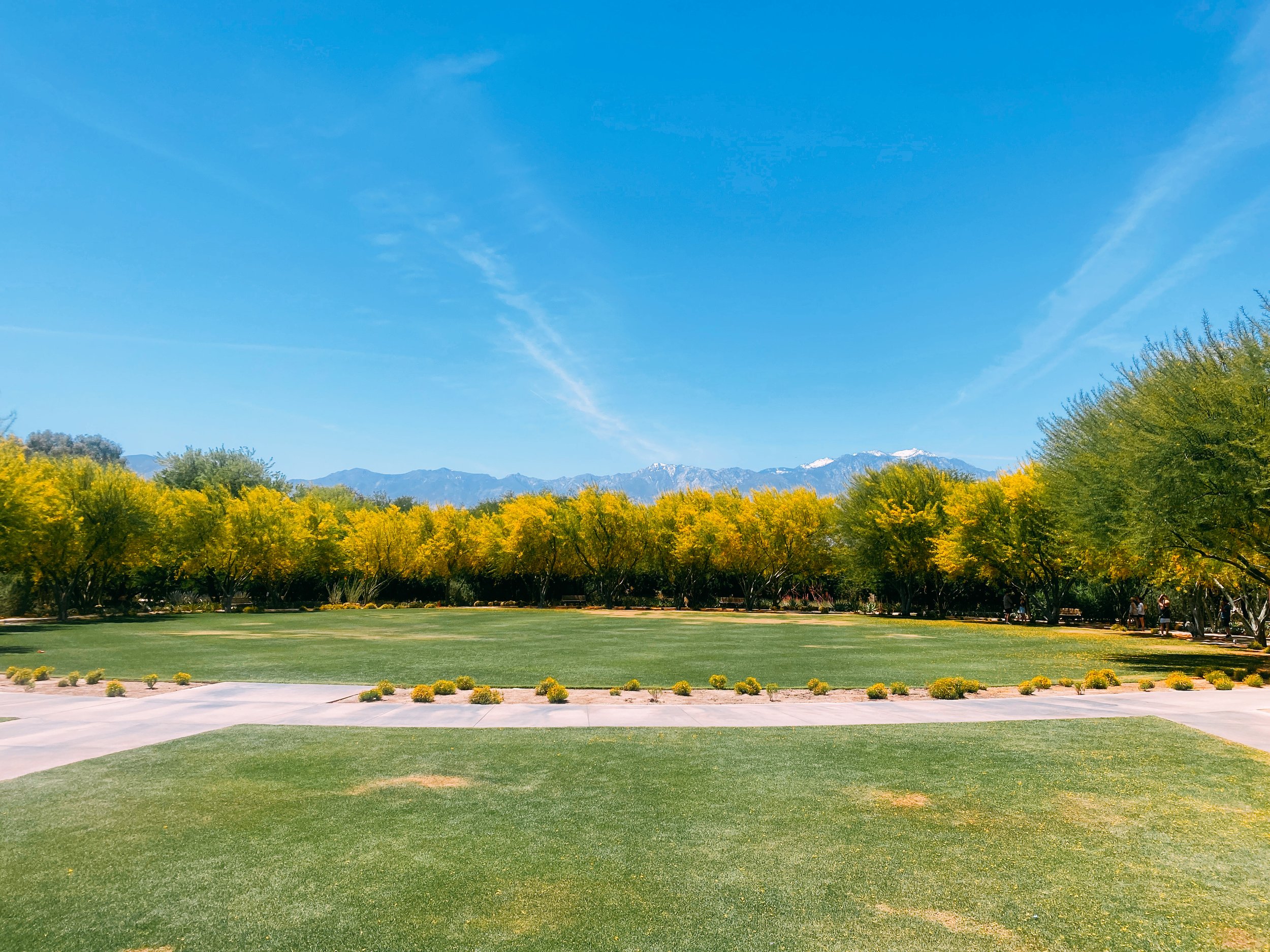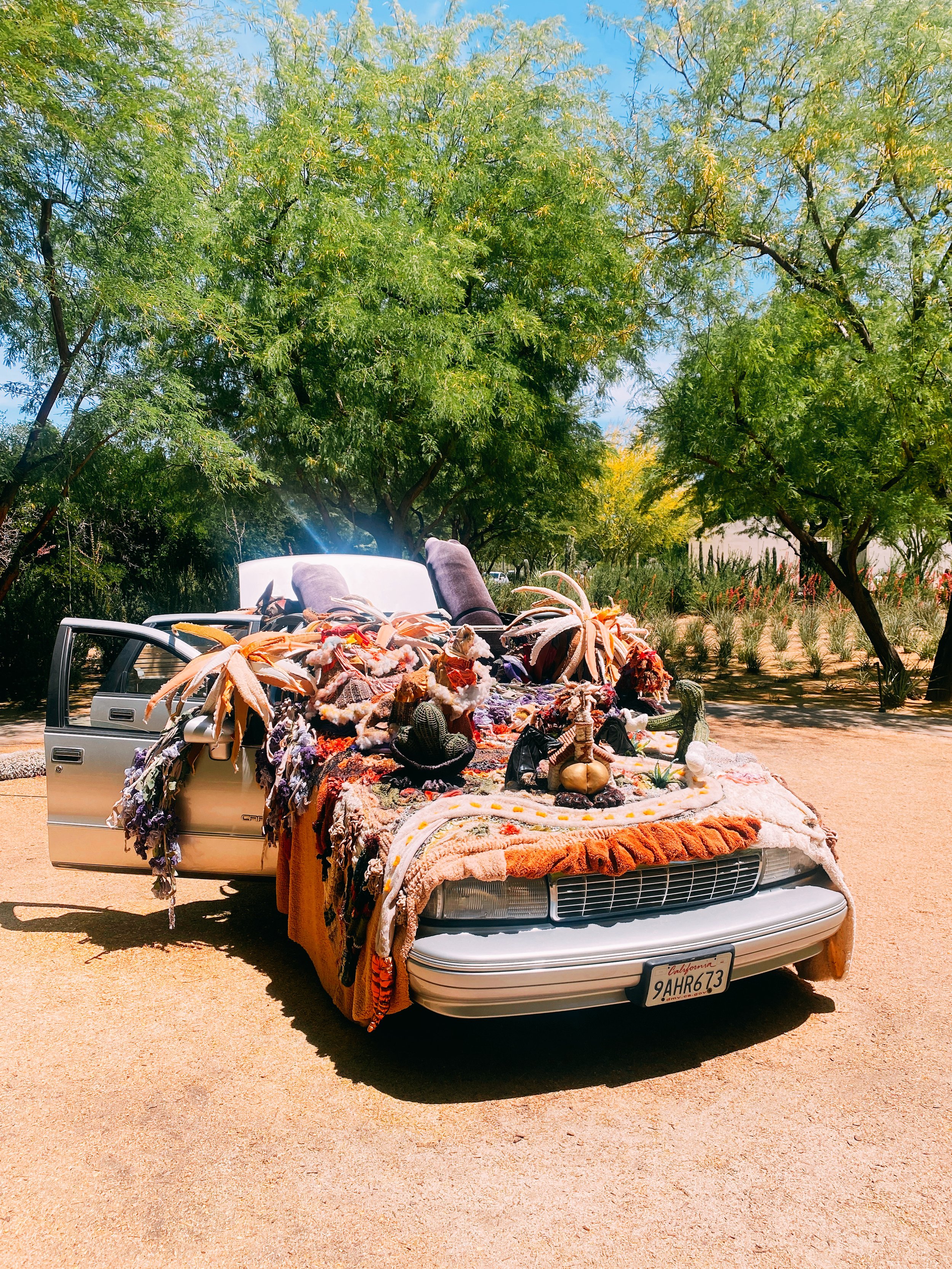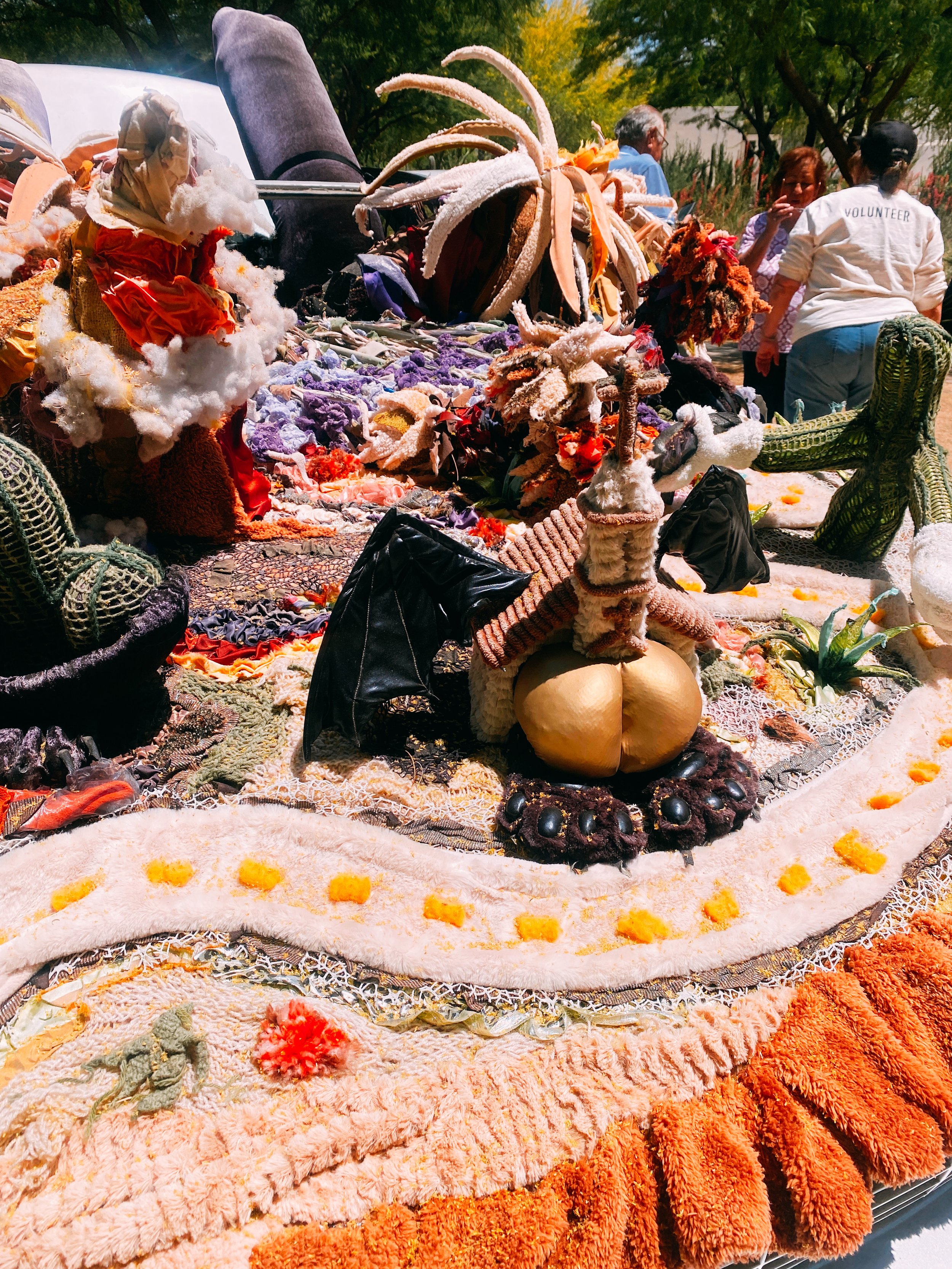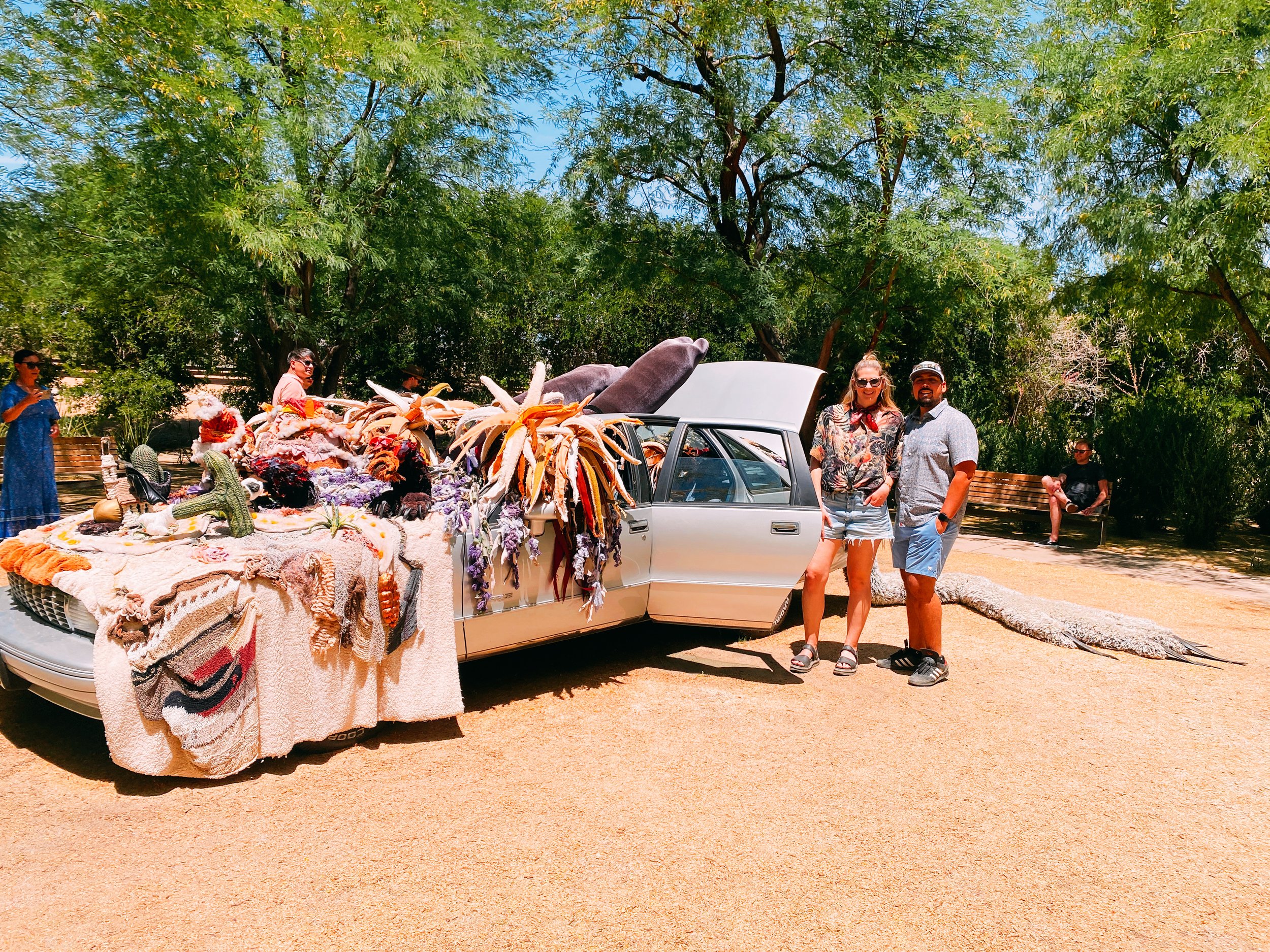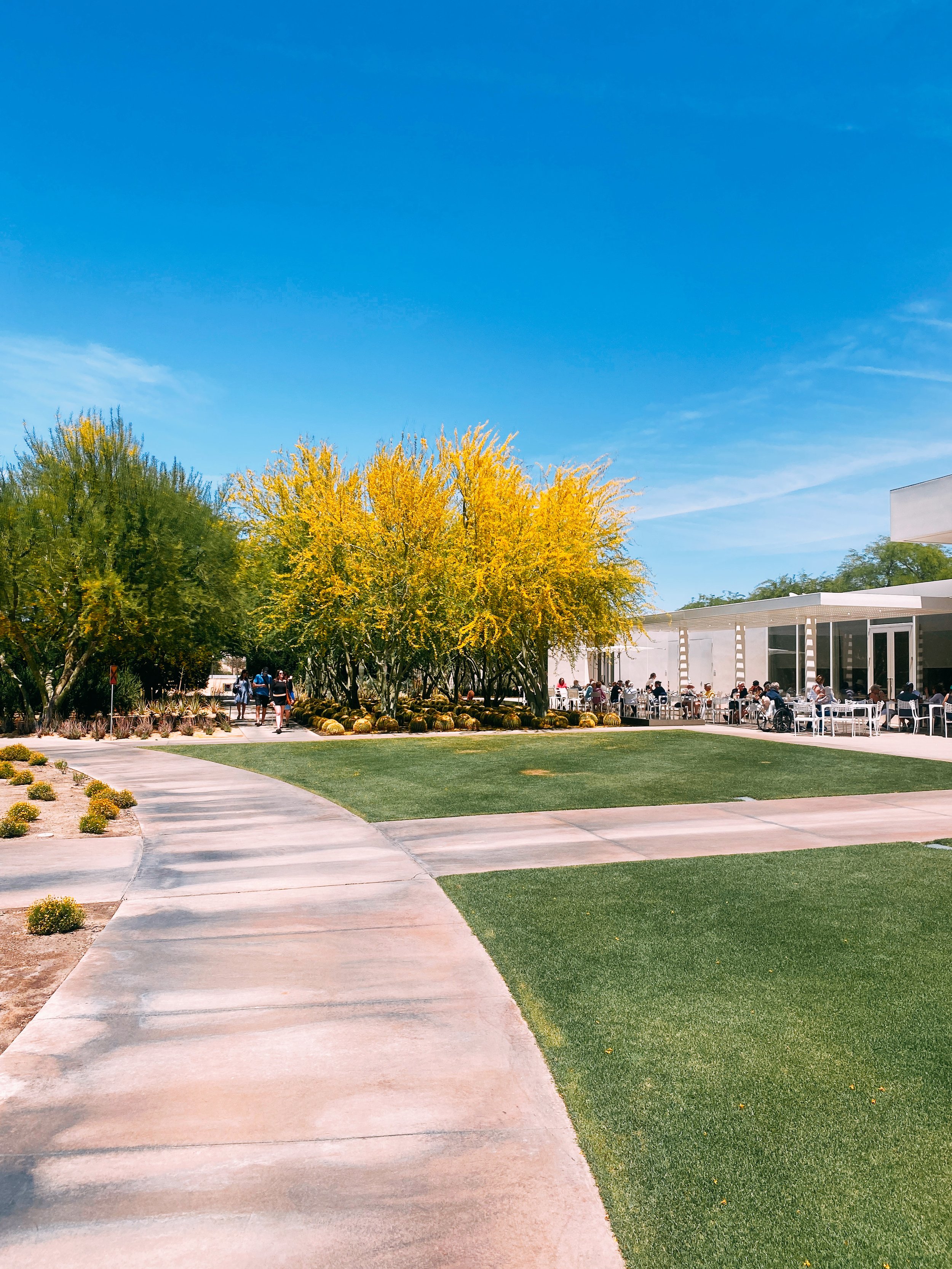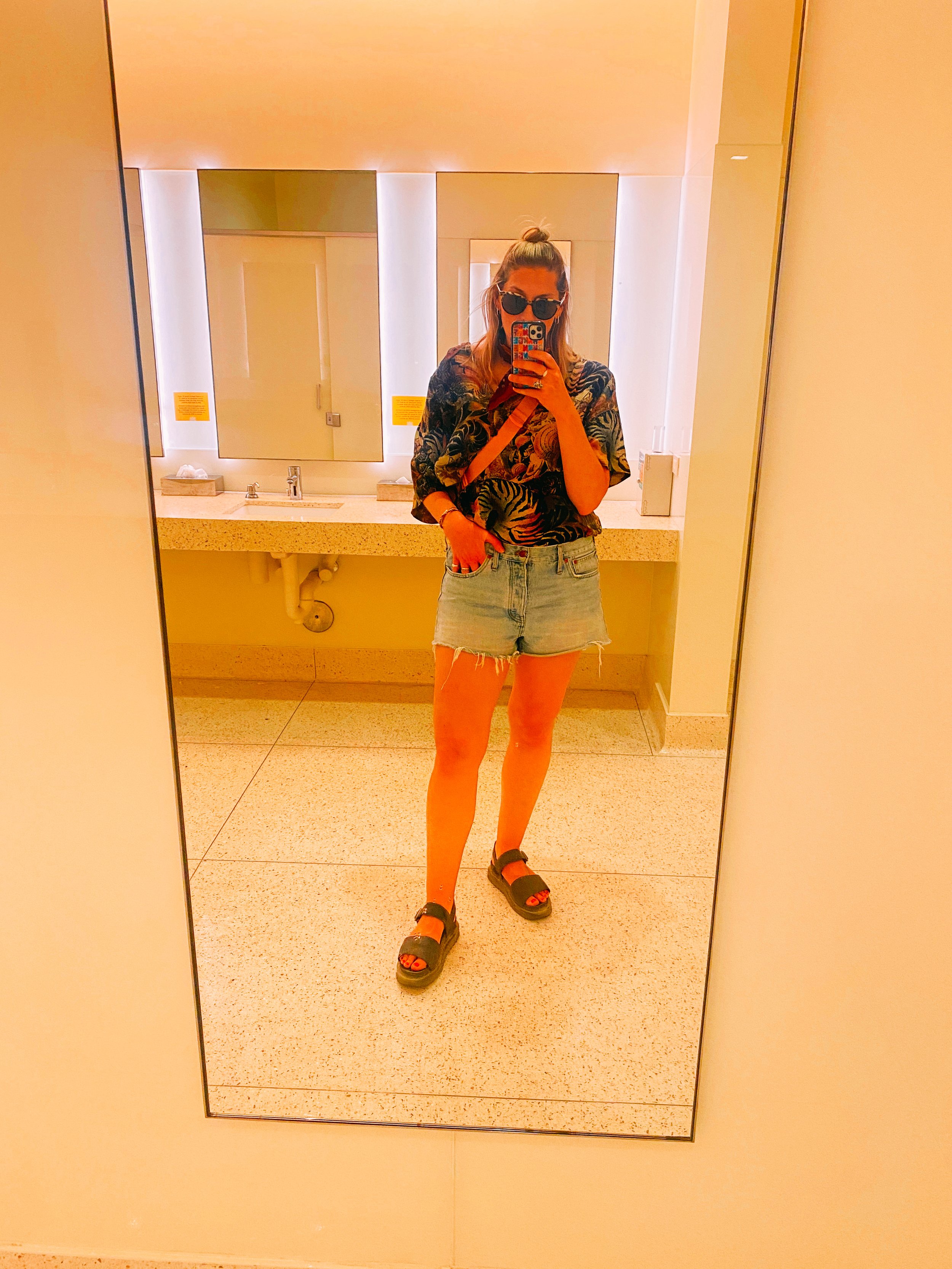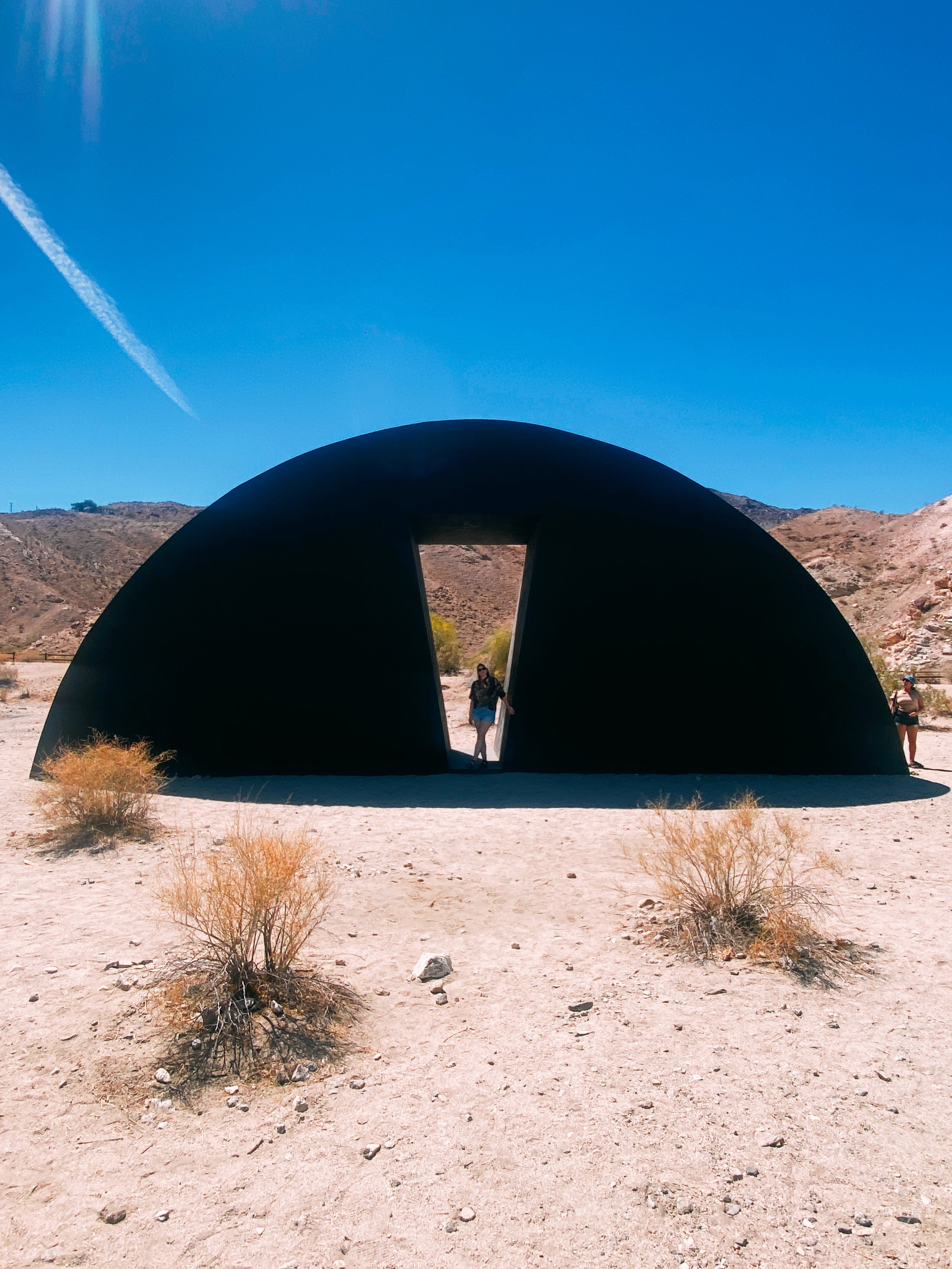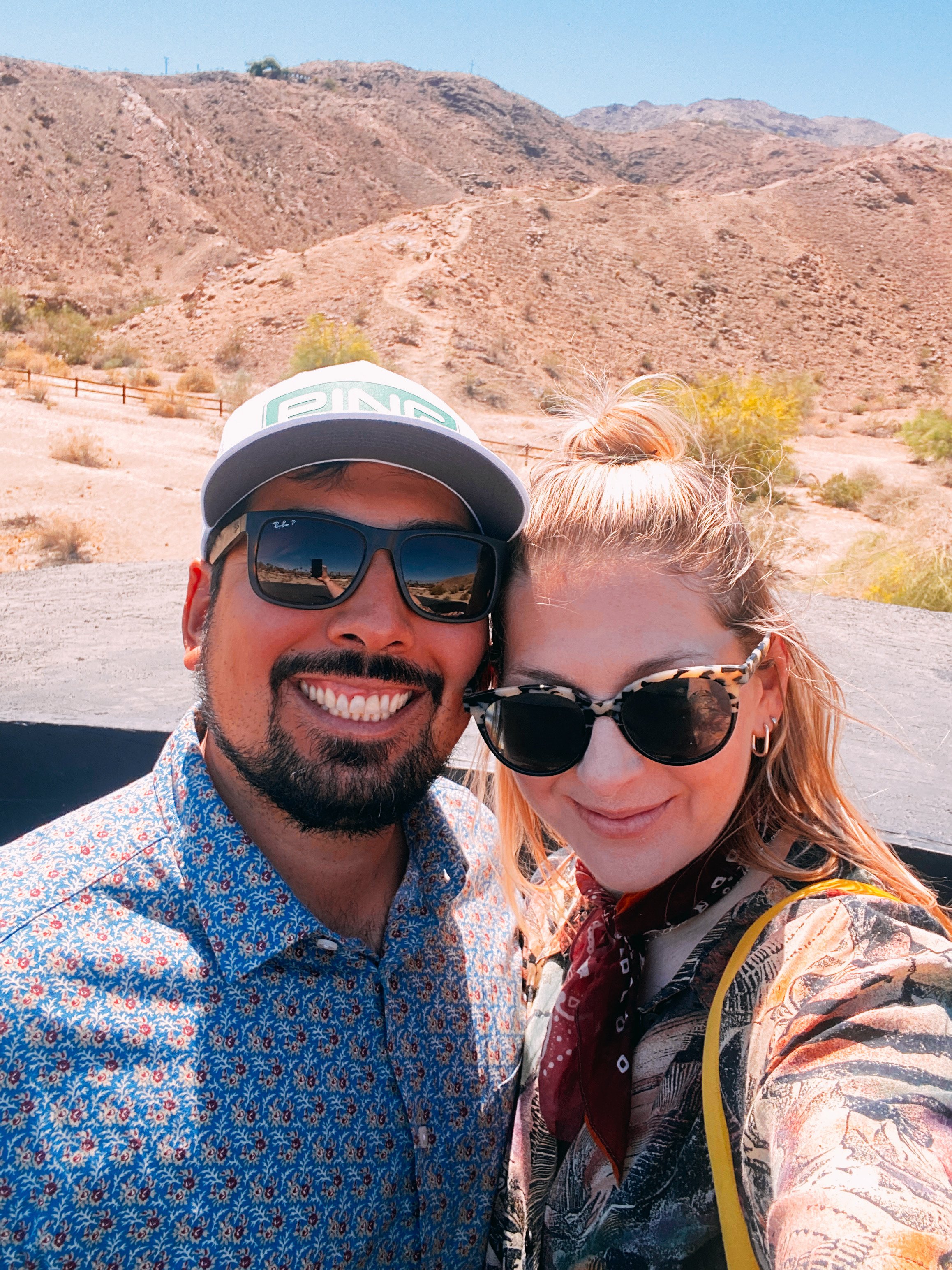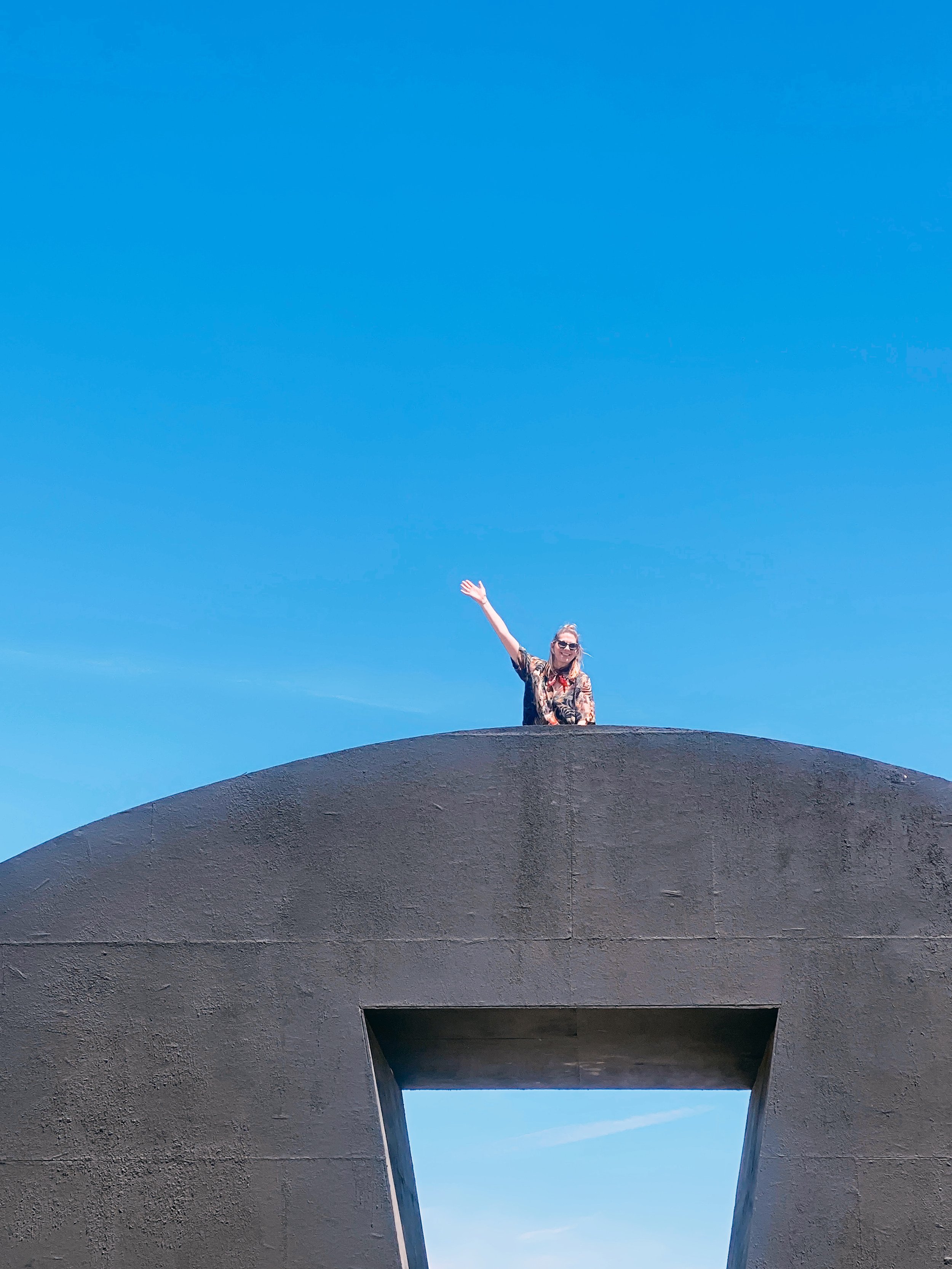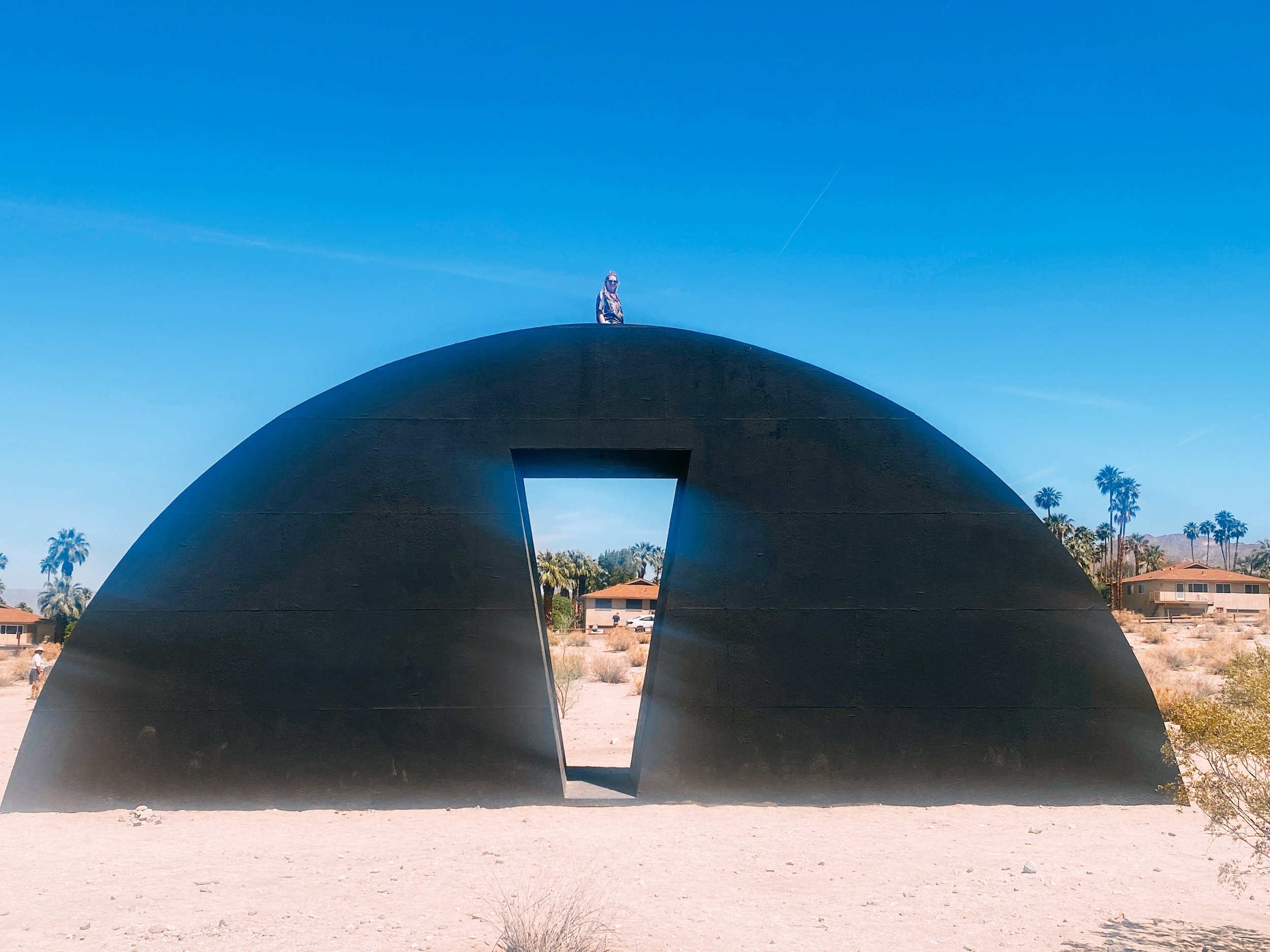Desert X 2023
Another Desert X has come and gone and this year’s was full of inspiration and intrigue against the wide open landscape of Palm Springs. Come with me as I take you on a little tour!
Friday, May 5
Christian picked me up at my school site so we could hit the road immediately. I always underestimate how long the journey to Palm Springs is. “It’s definitely under two hours”, I always say, but really with the Friday afternoon traffic, it’s a little over three, door to door. We take the back way in through the mountains and make it into town just in time for our 7:00 reservation at Mister Parker’s. We change into fancier regalia in the car because Mister Parker’s has a dress code.
We’re greeted by the general manager who shows us to our table in the dimly lit romantic restaurant. It’s so dim in fact that they give you little flashlights to read the menu, which you get to keep as a souvenir. (I love this.) Our waiter brings over a candle and I think, “How romantic, a real candle!” After getting our drinks she explains that the candle is actually made of butter and we are encouraged to dip our bread into the melting puddle. This butter was so rich and exquisite and the sourdough bread was so sour, just how I like it. We had a great dinner to start off our trip, nightcapping at the secret bar and sitting in the common room. Christian and I have had a love affair with The Parker since our first Desert X in 2019 and our experience just wouldn’t be complete without a stop in there. We had an excellent time and were ready to head to our hotel to rest in preparation for the next day.
Saturday, May 6
We get up early and grab some coffee since we have an artist’s talk to get to by 9AM. This year I scheduled several lectures by different Desert X artists and I’m so glad that I did. First, we met Matt Johnson at his monumental Sleeping Figure. Sleeping Figure is a monumental sculpture made out of shipping containers, arranged to look like a reclining or sleeping person. It was fascinating to hear him discuss his process and the meaning behind the work. The work is situated between Interstate 10 and a freight line that connects the port of Long Beach to the Southwestern US. Shipping containers constantly whiz by carrying goods from distant lands. Johnson sought to explore the idea of creating a resting figure from these containers that represent almost constant motion. It was fascinating to hear how the sculpture was conceptualized, planned, and built, taking a lot of engineering to create something that was stable and safe for people to be near. It was very windy which added to the landscape’s motion in juxtaposition to the sleeping figure.
After the talk, we headed out to see several of the other installations. We began at Namak Nazar by Holozoic/Desires which incorporated sound as well as site-specific installation to play with metaphor surrounding conspiracy, UFOs, climate change, and hope for the future. Mario García Torres’ Searching for the Sky (While Maintaining Equilibrium) was an installation created from 23 mechanical bull mechanisms arranged as a herd in the desert landscape. Each mechanism had a reflective surface attached to the top which highlighted the jerky and alien movements of the “bulls”. The piece examined man’s relationship to nature, specifically our dominance over animals. Next, we headed to Tschabalala Self’s Pioneer, a sculpture situated in a palm oasis. The sculpture shows a headless and armless woman riding on/jumping over a horse. The woman’s hands rest on her thighs in an energized gesture. The sculpture pays homage to the collective foremothers of America and how the labor of Indigenous, Native, and African women allowed for American expansion. We explored two more installations Immersion by Gerald Clarke and Originals by Tyre Nichols. Immersion was a gamified installation where players can advance on the gameboard by answering interactive trivia questions. The gameboard itself is representative of Cahuilla basket weaving and the game immerses players in the natural and cultural history of the Native Americans of the Coachella Valley. Tyre Nichols’ name might sound familiar to you. He was murdered by police in Memphis, Tennessee on January 7 of this year. A series of his landscape photographs were enlarged as billboards alongside Gene Autry trail. The work serves as a grim reminder of that which we lose to police brutality and to continue the fight towards police reform. The photographs are familiar, sunsets and buildings, with a poignancy that comes from a life violently cut short.
After visiting the installations we headed to the Palm Springs Art Museum to attend two artists lectures. First, we listened to Desert X: Architectures of Survival and Liberation with Marina Tabassum and Torkwase Dyson. We got to watch Tabassum’s film Khudi Buri which showed the process of creating the khudi baris or tiny houses for Bangladeshis residing on chars in the Ganges river. These chars are subject to flash flooding and change over time. I found the footage of how the path of the Ganges has changed over the last 20 years to be fascinating. The khudi baris are relatively cheap, easy to build, modular, and can be transported when flooding occurs. Dyson also discussed her work with architecture and how we can utilize architecture to build new futures infused with freedom and autonomy asking, “How do we create multiple vantage points?” I loved listening to her process and how she progressed into architecture from painting. It made me very excited to see her installation the next day.
We had a brief intermission so we went to look around the museum. The Palm Springs Art Museum has some heavy hitters, I especially loved the large Helen Frankenthaler upstairs. Lots of modern art as well as a few pieces by Desert X alums including Gerald Clarke. After the intermission, we listened to another lecture with Doug Aitken, who’s mirrored house installation Mirage from Desert X’s inaugural run in 2017 is the stuff of legend. I liked listening to him discuss how art can become more participatory for the viewer and how we can move art from this protected category that lives inside white walls of museums and galleries out into the world where it can be more discursive and generous to the viewer. I took a lot of notes on my phone about living artwork, artwork that encompasses the ecological, and dematerial, and how there can be new systems of communication within networks of knowledge. Aitken discussed using the palette of what’s available in the area and that really resonated with me, as a found object artist myself. I’m so glad I signed up for these artists’ lectures because they made the Desert X experience come alive for me a bit more and added a depth to my understanding of the work.
After this we were pretty tired so we headed back to the hotel for some pool time. We ventured out into Palm Springs for dinner, settling on Tailor Shop where we had drinks and yummy snacks.
Sunday, May 7
Sunday morning we were able to relax a little bit before heading out to see the rest of the installations. We had a great time having our coffee and breakfast by the pool. It’s been a cold, long winter season in San Diego and the warm desert sun felt so good on my skin. I loved looking at the palm trees and the mountain peak just over the roof of our hotel. Something I love about the desert is the decompressing experience of space. In San Diego, you’re always running up against other people and buildings and things, especially in the urban area I live in. Getting out to the desert lets your spirit expand a little bit and you can see miles and miles of open space. It’s good for you. After the pool we headed over to Mojave Trading Post which is one of my favorite stores in Palm Springs. Of course, I got a few trinkets to enjoy and then we headed back out into the desert.
First, we saw Rana Begum’s No.1225 Chainlink, a mazelike installation of yellow chainlink fencing that explored protection versus exclusion and what passes through the chainlink. The installation changes with the light in the environment and you feel a lightness the further you move inside, which was surprising. Next, we headed to one of our favorite spots in Palm Springs, Sunnyland, to see Amar a Dios en Tierra de Indios, Es Oficio Maternal by Paloma Contreras Lomas. The interactive installation consisted of an old car filled with stuffed, alien forms that comment on the romanticization of toxic masculinity in Hollywood films and the culture at large. Inside, a film played that told the story of these strange characters in a western-meets-sci-fi fashion. We spent some time walking around the grounds and enjoying the botanicals and labyrinths. I love the vibrancy of the gardens at Sunnyland, it demonstrates that the desert landscape is anything but dead.
Finally, we made it to Torkwase Dyson’s Liquid A Place. After listening to her speak at the Palm Springs Art Museum, I was most excited to see this installation. The installation comments on our connection to water and that we are the water in a place. We are able. to access our memory through water and the memory of water in the desert. Liquid A Place allows the viewer to climb to the top and survey the land from a new vantage point. Interestingly, there have been historic rains this year and as we drove through the desert we saw the channel full of rushing water from the snowmelt. The mountains even had a little bit of remaining snow. This brought another layer to the context of water in the desert examined by Dyson. I found the piece to be contemplative and changed my experience to the landscape as its rough surface radiated heat.
We unfortunately missed one installation by Lauren Bon and Metabolic Studio, The Smallest Sea with the Largest Heart. I’m bummed because many of the artists were talking about it at the lectures we attended. We would have had to wait hours to see it and we were kind of ready to head home after visiting the last artwork. However, I found the experience of Desert X this year to be very enriching to my artistic practice and the array of artists was diverse and conceptually interesting. I have been given much to consider between now and Desert X 2025.
Traveling to see art in new contexts always expands my worldview and makes me see things a little differently. On the I-15 there’s this bridge that comes right before you get to Temecula that I’ve always loved. It’s simple and beautiful yet the structure is powerful and strong. After experiencing Dyson’s Liquid A Place I thought about how architecture itself is a bridge between ourselves and our environment. What will we carry with us? How can we change the culture of the future through what we build? These are the questions I’m contemplating after my Desert X experience.


